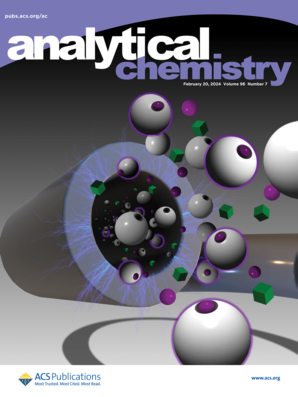Probing Orientational Dynamics of Magnetic Nanoparticles in Opaque Samples Using Near-Infrared Magnetic Linear Birefringence
IF 6.7
1区 化学
Q1 CHEMISTRY, ANALYTICAL
引用次数: 0
Abstract
We demonstrated the advantage of magnetic linear birefringence (MLB) measurement for studying the orientation dynamics of magnetic nanoparticles (MNPs) in various environments. It is expected that MNPs will be utilized as active probes of nanoscale measurements, such as nanorheology and homogeneous bioassay. The optical anisotropy induced in MNP suspensions under an AC magnetic field, including MLB, reflects the physical rotation of the MNP itself. MLB is measurable with near-infrared light, which can reduce undesirable extinction due to the scattering or absorption by the sample suspension. In this study, we built an apparatus for precise MLB measurement by refurbishing the previous one to measure magnetic linear dichroism under an AC magnetic field and confirmed the relationship between the MLB signal and the orientation of MNP. Then, two systems that were opaque for visible light were examined to show the unique advantage of the MLB measurement of MNPs: (1) MLB measurement applied to the MNP suspension with a wide concentration range, and the effect of the interparticle interaction on the orientation dynamics could be detected from MLB frequency spectra. (2) Magneto-liposomes (ML), small vesicles containing MNPs, could be measured, and the frequency spectra could provide information on the condition of MNPs in ML. Furthermore, it was possible to detect the phase transition of the lipid bilayer from the gel to the liquid crystal phase.

利用近红外线性双折射探测不透明样品中磁性纳米颗粒的取向动力学
我们证明了磁线性双折射(MLB)测量在研究磁性纳米颗粒(MNPs)在不同环境中的取向动力学方面的优势。预计MNPs将被用作纳米尺度测量的活性探针,如纳米流变学和均相生物测定。包括MLB在内的MNP悬浮液在交流磁场作用下产生的光学各向异性反映了MNP本身的物理旋转。MLB可以用近红外光测量,这可以减少由于样品悬浮液散射或吸收而产生的不良消光。在本研究中,我们在原有仪器的基础上,在交流磁场下建立了一套精确的MLB测量仪器,用于测量磁线性二色性,并确定了MLB信号与MNP取向之间的关系。在可见光不透明的两种体系中,MLB测量MNPs的独特优势体现在:(1)MLB测量适用于大浓度范围的MNP悬浮液,并且MLB频谱可以检测到粒子间相互作用对取向动力学的影响。(2)磁脂质体(Magneto-liposomes, ML)是一种含有MNPs的小囊泡,其频谱可以提供MNPs在ML中的状态信息,并且可以检测到脂质双分子层从凝胶相到液晶相的相变。
本文章由计算机程序翻译,如有差异,请以英文原文为准。
求助全文
约1分钟内获得全文
求助全文
来源期刊

Analytical Chemistry
化学-分析化学
CiteScore
12.10
自引率
12.20%
发文量
1949
审稿时长
1.4 months
期刊介绍:
Analytical Chemistry, a peer-reviewed research journal, focuses on disseminating new and original knowledge across all branches of analytical chemistry. Fundamental articles may explore general principles of chemical measurement science and need not directly address existing or potential analytical methodology. They can be entirely theoretical or report experimental results. Contributions may cover various phases of analytical operations, including sampling, bioanalysis, electrochemistry, mass spectrometry, microscale and nanoscale systems, environmental analysis, separations, spectroscopy, chemical reactions and selectivity, instrumentation, imaging, surface analysis, and data processing. Papers discussing known analytical methods should present a significant, original application of the method, a notable improvement, or results on an important analyte.
 求助内容:
求助内容: 应助结果提醒方式:
应助结果提醒方式:


